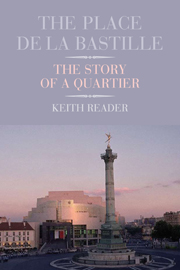Book contents
- Frontmatter
- Contents
- Acknowledgements
- Map by Stephen Ramsay Cartography
- Introduction: The Place de la Bastille
- 1 ‘What's that poor creature doing here?’: the area and the fortress before the Revolution of 1789
- 2 ‘Thought blew the Bastille apart’: the fall of the fortress and the revolutionary years, 1789–1815
- 3 ‘The strategy of the generals of Africa shattered’: the Restoration, Orleanist and Second Republic Years, 1815–1851
- 4 ‘Where is the noise of the storm that I love?’: The Second Empire from Haussmann to the Commune
- 5 ‘Satan's bagpipes’: La Belle Époque's forty-three years of peace
- 6 ‘Villains, stars and everybody in between’: The First War and the entre-deux-guerres
- 7 ‘Slicked hair and splendid sideburns’: Occupation and Liberation
- 8 ‘Let's have some sun!’: post-Gaullism and the Mitterrand years
- 9 ‘A building, not a monument’: the construction of the Bastille Opéra
- 10 ‘A real earthquake’: the impact of the Opéra on the quartier
- 11 Flânerie in the archive: the Faubourg/Bastille today
- Notes
- Bibliography
- Index
9 - ‘A building, not a monument’: the construction of the Bastille Opéra
- Frontmatter
- Contents
- Acknowledgements
- Map by Stephen Ramsay Cartography
- Introduction: The Place de la Bastille
- 1 ‘What's that poor creature doing here?’: the area and the fortress before the Revolution of 1789
- 2 ‘Thought blew the Bastille apart’: the fall of the fortress and the revolutionary years, 1789–1815
- 3 ‘The strategy of the generals of Africa shattered’: the Restoration, Orleanist and Second Republic Years, 1815–1851
- 4 ‘Where is the noise of the storm that I love?’: The Second Empire from Haussmann to the Commune
- 5 ‘Satan's bagpipes’: La Belle Époque's forty-three years of peace
- 6 ‘Villains, stars and everybody in between’: The First War and the entre-deux-guerres
- 7 ‘Slicked hair and splendid sideburns’: Occupation and Liberation
- 8 ‘Let's have some sun!’: post-Gaullism and the Mitterrand years
- 9 ‘A building, not a monument’: the construction of the Bastille Opéra
- 10 ‘A real earthquake’: the impact of the Opéra on the quartier
- 11 Flânerie in the archive: the Faubourg/Bastille today
- Notes
- Bibliography
- Index
Summary
The Bastille Opéra was one of François Mitterrand's grands projets, also known as grands travaux – a dozen or so highly ambitious architectural realizations which left the President's mark on Paris in a manner sometimes described, not flatteringly, as reminiscent of the monumental schemes of the Egyptian Pharaohs. Three of these – the Institut du Monde Arabe, the Musée d'Orsay (both on the Left Bank) and the Cité des Sciences at La Villette, in the north-east of the city – had in fact been embarked upon under Giscard, though they were completed during Mitterrand's first term. Among the others, the best-known are the Grand Louvre, centred on a glass pyramid, which gave the museum sorely needed new space; the Grande Arche out at La Défense, in the western suburbs, inaugurated during the 1989 bicentennial celebrations; and the Bibliothèque de France, where much of the research for this book was carried out. This was not opened until December 1996, when Jacques Chirac named it the Bibliothèque François Mitterrand in homage to the instigator of the project.
The Opéra's history is a chequered and frequently internecine one, in which political manoeuvring seems to loom larger than musical or aesthetic considerations. Before its opening Paris's main opera house had been for 114 years the opulent Palais Garnier, in the 9th arrondissement, which was utterly unsuited to contemporary music and concentrated on extremely costly sets and productions, only one of which could be housed at any one time.
- Type
- Chapter
- Information
- The Place de la BastilleThe Story of a Quartier, pp. 130 - 135Publisher: Liverpool University PressPrint publication year: 2011



